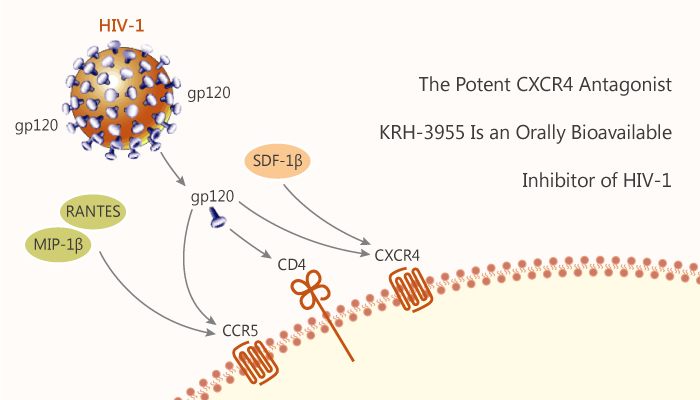CXCR-4 is an α-chemokine receptor specific for SDF-1, which is a molecule with the strong chemotactic activity of lymphocytes. Specifically, CXCR-4 is a receptor of stromal cell-derived factor-1 α and human immunodeficiency virus type 1 (HIV-1), belonging to the chemokine receptor family. Besides, CXCR4 is one of several chemokine co-receptors for HIV-infected CD4+ T cells. Chemokine receptors CXCR4 and CCR5 are the major co-receptors of HIV-1, while CD4 is the main receptor for virus entry. SDF-1 α is a ligand of CXCR4 and can prevent infection of X4 HIV-1 strain using CXCR4. Moreover, CXCR-4 plays a key role in guiding cancer cell migration to the tumor site and HIV-1 infection. SDF-1 α interacts with CXCR4 to promote the progression and treatment of acute lymphoblastic leukemia and the treatment of aggravating rheumatoid arthritis. KRH-3955 is an orally bioavailable CXCR4 antagonist and is also a highly potent and selective inhibitor of X4 HIV-1.

KRH-3955 hydrochloride is an orally bioavailable CXCR4 antagonist and is also a highly potent and selective inhibitor of X4 HIV-1.
But, how does KRH-3955 hydrochloride protect against HIV-1 infection? Let’s discuss it in detail. In the beginning, KRH-3955 hydrochloride is an orally bioavailable CXCR4 antagonist. KRH-3955 hydrochloride selectively inhibits SDF-1α binding to CXCR4 with an IC50 of 0.61 nM. Furthermore, KRH-3955 hydrochloride is also a highly potent and selective inhibitor of X4 HIV-1, with an EC50 of 0.3 to 1.0 nM.
In the second place, KRH-3955 inhibits the replication of NL4-3 in activated peripheral blood mononuclear cells (PBMCs) from eight different donors with the EC50 ranging from 0.23 to 1.3 nM. Meanwhile, KRH-3955 inhibits the infection of CD4/CXCR4 cells by these recombinant drug-resistant viruses with the IC50 ranging from 0.4 to 0.8 nM. Nonetheless, KRH-3955 inhibits the SDF-1α-induced increase in the intracellular Ca2+ concentration in a dose-dependent manner. Importantly, KRH-3955 binding sites are located in a region composed of all three extracellular loops (ECLs) of CXCR4. Particularly, KRH-3955 inhibits MAb 12G5 binding to CXCR4 mutants, with the IC50 ranging from 0.5 to 14.1 nM
Last but not the least, KRH-3955 efficiently suppresses X4 HIV-1 infection in hu-PBL-SCID mice. Interestingly, KRH-3955 exhibits moderate oral bioavailability (25.6%) and Cmax (86.3 ng/mL). Obviously, KRH-3955 exhibits terminal elimination half-lives (99 h) due to high plasma clearance (3.9 liters/h/kg) combined with large volumes of distribution (374 liters/kg).
All in all, KRH-3955 hydrochloride is an orally bioavailable CXCR4 antagonist and is also a highly potent and selective inhibitor of X4 HIV-1.
References:
Ben-Hail D, et al. J Biol Chem. 2016 Nov 25;291(48):24986-25003.